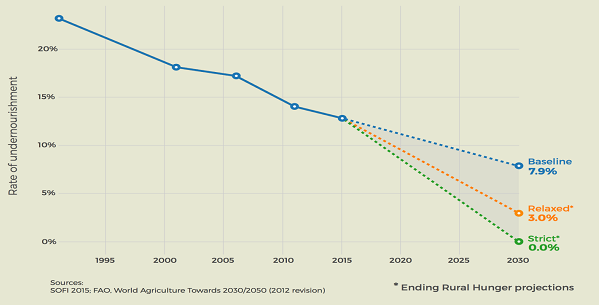The State of Food Insecurity 2015 report shows that undernourishment in the developing world is falling by about one percentage point every three years. At this rate, in 2030 the world will still have 720 million undernourished people, or 7.9 percent of its population. This is business as usual.
If we want to end hunger, we must bend this curve and scale up our interventions to achieve faster progress. If we define ending hunger as getting undernourishment to the levels of today’s rich countries (which are at or below 3 percent), then we have to double our rate of progress and reduce undernourishment by 2 percentage points every three years. If we want to define ending hunger more precisely around an agenda of “leave no one behind” by aiming for 0 percent undernourishment, we must triple our rate of progress and reduce undernourishment by almost 3 percentage points every three years.
Figure 1. Undernourishment in the developing world
Baseline scenario and “Ending Rural Hunger projections”

This is the background to the discussion taking place today in Addis Ababa, Ethiopia on investing in rural people and the main reason why the second Sustainable Development Goal (SDG2), “End hunger, achieve food security and improved nutrition, and promote sustainable agriculture” is so critical. The SDG also reminds us that we are not only concerned about undernourishment, but also about malnutrition, agricultural productivity, and the implementation of sustainable, inclusive, and resilient agricultural practices. In doing this, the new sustainable development agenda goes well beyond the expiring Millennium Development Goals (MDGs) to a broad concept of better food systems, something that the International Fund for Agricultural Development (IFAD) has long promoted. In fact, those at the Third International Conference on Financing for Development explicitly recognize IFAD’s efforts. This is a nice compliment but also presents a challenge: how can impact be scaled up to meet the more ambitious goals that have now been set?
It is useful to start with one clarification. There are those who argue that ending hunger is a matter of producing more food, and that is best done by large, commercial farms. I think most people agree that a central issue in addressing global hunger is that many rural people and smallholders are unable to access or afford food. There are about 500 million family farms in the world today, supporting around 2.5 billion people. It is clear that even if the long-run development path will imply movement of these people to urban areas and consolidation of their land-holdings into larger farms, this will not happen in the next 15 years. By 2030 most of these 2.5 billion people in family farming households will still be in situ. Rural transformations must support their evolution into more organized, efficient, and sustainable farming at the same time as it promotes large scale agriculture.
Rural transformation is a big and broad concept, but it can be usefully subdivided into four big transformations that need to occur if smallholder agriculture is going to become synonymous with efficient and sustainable family farming and if we are going to be able to achieve SDG 2.
- The first transformation is in promoting family farms as successful businesses rather than dismissing them as subsistence activities. Smallholders must be integrated into domestic markets. Too many lack access to inputs, financial services, and markets and to knowledge about prices, weather forecasts, extension services, and other information. They cannot compete successfully because of the high transaction costs of bringing them into the circle of market activities. They need roads and energy. They must be organized and their bargaining power improved vis-à-vis market middle men.
- The second transformation has to do with making agricultural markets function better, both globally and nationally. We forget sometimes that agriculture has not had the same intense globalization as other sectors. Since 1990, manufacturing exports, expressed as a share of global manufacturing value added, have doubled from 50 percent to over 100 percent. Meanwhile agricultural exports have been relatively flat, increasing only from 30 percent to 40 percent. Agricultural commodities are still thinly traded, knowledge about food stocks is skimpy, supply and demand shocks are large, and prices are volatile. Agricultural markets are increasingly closely tied to oil prices both because oil is an important input into transport and fertilizer, and because biofuels now compete for land with cereals and other crops. Nationally, agriculture is often subject to a range of price distortions and subsidies, and little priority is given to promoting a rural investment climate that supports smallholders, including women.
- The third transformation is the integration of resilience and sustainable intensification into agricultural practices. Governments must introduce programs to help farmers adapt to climate change and combat the deterioration of land and soil quality, and they should put in place safety nets and insurance schemes that will permit small farmers to take on the risks that sometimes come with moving out of subsistence and into commercial agricultural production.
- Fourth, there has been considerable underinvestment in research into the kinds of crops that are important to smallholders, especially those in Africa, and a corresponding lack of investment in into national agricultural research systems. New initiatives like GrowAfrica and GrowAsia are trying to address this gap, but more needs to be done. The research has to be both technical as well as socio-economic, to make sure that promising new technologies will be taken up by farmers, including women farmers.
A focus on achieving these four transformations could bend the curve of ending global hunger and achieving food security.
This blog draws on content from a FFD side event on July 14 entitled “Realizing the Vision: Investing in Rural People for Inclusive and Sustainable Transformation,” and moderated by co-editor of the Future Development blog and Senior Fellow and Deputy Director of the global economy and development program at the Brookings Institution Homi Kharas.


Commentary
Dispatch from #FFD3: Investing in rural people for inclusive and sustainable transformation
July 14, 2015